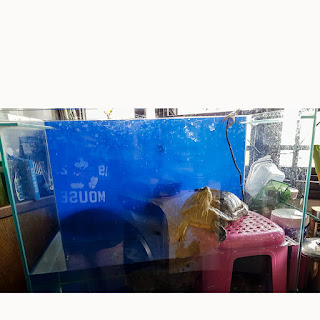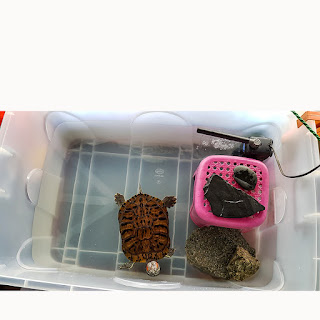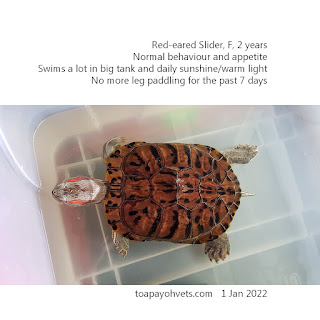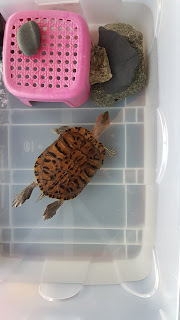BE KIND TO PETS VETERINARY STORIES.
Dr Sing Kong Yuen, BVMS (Glasgow)
Video 5/5 - 8 DEC 2021 and 1 JAN 2021. THE PADDLING RED-EARED SLIDER
is NOW eating and no longer paddles her hind legs
HISTORY
On 15 Nov 2021, the owner consulted me about her 2-year-old
female red-eared slider, Fei Fei, 1.6kg, . She had no appetite (anorexic)
for over 3 days, not passing stools (constipated?) and was paddling
her hind legs furiously. I had the slider in-patient for 3 days.
X-ray did not show eggs or gravel and stone inside her body. There was
some gas. Syringe feeding with pellets, antibiotics and multivitamins and
calcium and an anti-inflam injection IM. The slider was alert and active
but would not eat the pellets for 3 days. She passed a bit of poop on Day 3.
On 18 Nov 2021. When the slider went home on Day 3, she started eating. The owner
was very happy! She would stop spraying the chemicals (Biozym and
Nutrafin Aqua Plus) when she changed the water in the tank. She
had been using them for the past 1 year. She asked and I advised
40-80 Nutrafin pellets daily and to feed a variety of food like vegetables,
chicken and prawn. LOTS OF EXERCISES OUTDOORS, but she said the
area downstairs was dirty and had dog poo. So she put the slider inside
a red plastic container for basking in the sunlight if she works from
home (Covid-19 pandemic times).
On 25 Nov 2021, the owner WhatsApp a video of the slider paddling
again and not eating. What was the problem? How to resolve it?
I asked her to WhatsApp images of her tank housing, basking
management (no UV lamp), water filtration (Hailea RP 400 internal filter).
To my surprise, the tank was TOO SMALL for this slider
1.6 kg and 28-cm long in midline length of the carapace from the
neck to the tail!
To shorten the story, I advised her to buy a much bigger plastic
container, at least triple the present tank volume. "Where do
you buy it?" she WhatsApp me. "Toyogo has all sizes," I replied.
The owner used her pink stool as the basking platform which
included a rock for the slider to dry up when she is not diving in
to swim and exercise. Now she brings her out on the clean grass
patch to exercise and get sunshine so that the slider can
make Vit D.
She continued the Multivitamin and Calcium supplement I had
prescribed for her, by smearing it onto the pellets. Now she feeds
some cooked prawn and chicken which she had not done so
for fear that the slider would not eat pellets anymore.
On 3 December 2021, the owner WhatsApp: "Hi Doctor,
my terrapin back to normal. Thank you for your advice."
I WhatsApp: "How do you know she has recovered?".
She texted: "She eats by herself." I WhatsApp: "Any leg paddling?".
She texted: "No more. Good appetite and poo is long" .
I WhatsApp: "What you fed past 2 days?".
She texted: "Pellets with vitamins & calcium prescribed by you."
I asked and she WhatsApp two videos (Videos 2/3, 3/3) of
her slider eating noisily and ravenously in the new SPACIOUS tank.
With tele consultation, her terrapin housing, feeding and exercise
management were changed for the better and there was no more paddling problems again.
On 1 Jan 2022, the owner reported that the slider is back
to normal since the past 7 days. A large water container for lots of swimming,
daily sunshine or heat lamp to warm the shell and the
multivitamins resolve the paddling problem. The owner
is very happy now.
What is the cause of this strange behaviour of leg paddling?
I would hazard a guess as it was not practical to do a
blood test unlike dogs and people to check for deficiency
of Vit D and calcium in the blood.
1. Leg paddling is commonly seen when the female red-eared slider wants to lay eggs. This was NOT a case of dystocia
(difficulty in laying eggs) as she had no eggs seen on the X-ray. Paddling for indoor apartment living sliders include paddling on the floor and going to the main door to be asked to be let out to the soil downstairs. Egg-laying and loss of appetite usually starts around 4 years of age but she is 2 years old. Her behaviour might be due to early maturity and "false pregnancy" leading to paddling behaviour, but this behaviour
has not been found by me on the internet searches.
2. My hypothesis is that the slider had "thigh muscle cramps,"
being confined with so little space to turn her body
around for most of the day and night (see images in the blog
https://2010vets.blogspot.com/2021/11/4043-red-
eared-slider-paddling-last-4.html
CONCLUSION. Image given by the happy owner shows the slider is normal. She did not send me a video. She shared her knowledge THAT lots of swimming, heat from daily exposure to sunshine till the upper shell feels warm to her hands if there is time and sunshine or heat lamp resolved her problem.
END OF TEXT FOR VIDEO PRODUCTION
-------------------------
Video 1/3 link at:
Video link
Video 2 /3 link at:
Video 3/3 link at:
Other Videos in YouTube of Toa Payoh Vets.
https://www.youtube.com/user/99pups
Updates and more information is in the blog
https://2010vets.blogspot.com/2021/11/4043-red-eared-slider-
----------------------------------
EXTRA IMAGES AND INFO FOR VIDEO PRODUCTION
X-ray shows no eggs in the abdomen
2.5 years - strange of hind leg paddling non-stop as if she wants to lay eggs
Antibiotics and anti-inflam injection IM
INPATIENT 3 days. Syringe feed pellets and Multivitamins + Calcium
Basking in sunlight for 1 hour daily

More spacious tank purchased on my advice.
Much more space to swim and exercise
Pink stool and rock are used as a basking drying platform

Another case of hind leg paddling
Can't lay eggs naturally
X-ray shows eggs in the abdomen
Oxytocin injection induced egg laying
No more anorexia and no more leg paddling
-----------------------------------------------
Sat 13 Nov 2021. 1.6 kg.
Female, 2.5 year old, Red eared slider by Google msg appointment with me.
Very active.
"Passed urine?" I asked.
"Normally will squirt out urine if held upside down like you are doing now," the owner in her late 40s said, but no urine squirted.
ANOREXIC. Keeps paddling frequently daily for past 3 days. As if "constipated". Had eaten chicken meat pieces
Ravenous usually. Was fatter.
X-ray V/D view. Gas in intestines. Boarded 3 days.
No eggs as (egg laying about 5 years of age)
- Monday 29 Nov 2021, 4.36 PM
- Recurrence of paddling. Why?
- WhatsApp:
- 'Hi Dr Sing, she ate three medium size cooked prawn yesterday? There was some poo in the water. However, why is she still paddling? She is still not interested to eat pellets'.
- My reply:
- 'Please let her swim in full tank of water for some 15 minutes with space to bask'.
"Noted with thanks!" - IMAGES
How you know she has recovered?
She eat by herself.
What happened?
Can I buy vitamins & calcium from you for my terappin?
Yes
How much is it?
$5.00 for 5ml container
Thank you! Will come & collect on Sat. Thanks a lot for your help!)
Any paddling?
No more. Good appetite & poo is long.
What you feed past 2 days?
Pellets with vitamins & calcium prescribe by you.
If you have questions or feedback please email us at 99pups@gmail.com
judy@toapayohvets.com for additional information
3067. A 7-year-old female red-eared slider is restless, paddling, not eating. Wants to lay eggs?
Behaviour for over 7 days. Paddling of legs, loss of appetite, restless,
Egg-bound?
Apartment too small to have pool and sand area.
Suggested a sand box as nesting area and access to water for feeding.
I advised oxytocin injection 2 days but owner wanted to wait and see.

REFERENCE below is from:
https://www.petmd.com/rc/red-eared-slider-trachemys-scripta-elegans
Red-Eared Slider - Trachemys scripta elegans
Red-eared sliders (also called red-eared terrapins) have been the most popular and commonly kept pet turtle for decades. They are the original dime-store turtle—until the Federal Government banned the sale of babies and juveniles smaller than 4 inches due to salmonella concerns in 1975, that is.
The red-eared slider is a subspecies of the pond slider, and as such doesn’t have its own recognized subspecies.
Red-Eared Slider Size
While most people may think of red-eared sliders as being small turtles, they can actually grow to almost two feet in length with proper housing and care! Adult males have longer tails than females and display distinct sword-like front claws, but females will grow to a larger size than their male counterparts.
On average, male red-eared sliders grow to be about 7.9 inches (20 cm) and females to about 11 inches (28 cm).
Red-Eared Slider Lifespan
Red-eared sliders can be especially long-lived, enjoying a lifespan of well over twenty years. The oldest recorded captive red-eared slider lived to be forty-one years old! In many cases, pet red-eared sliders are even passed down in families from generation to generation.
Red-Eared Slider Appearance
Red-eared sliders are quite attractive and rather flat turtles, with disc-shaped round carapaces (shells) in bright greens with thin yellow striping or blotches. They have yellowish underbellies and green skin, with yellow stripes or dots on their legs and faces.
Red-eared sliders get their name from the red spot or wide red stripe that’s found behind each eye. There are other types of turtles that look similar to the red-eared slider but which are lacking the red “ear.” The patterning of red-eared sliders begins a bright green but can stretch, darken, and fade as the animal grows and ages.
Another interesting fact about red-eared sliders is that, unlike other turtles, when they withdraw into their shells they are unable to seal off their shell entirely, leaving them vulnerable. So, in order to avoid predators they rely more on diving into deep water.
Red-Eared Slider Care Level
Because of their specific needs, keeping requirements, and long lives, red-eared sliders are recommended for intermediate to advanced herpetoculturists. However, if you’re interested in the animal and dedicated to providing the right kind of care for great lengths of time, beginning herpetoculturists can successfully raise red-eared sliders.
When deciding on a red-eared slider, or any other semi-aquatic or aquatic turtle, you must plan ahead and prepare for your pet before bringing it home. Any water turtle is generally much more difficult to care for since its environment strongly influences its health.
Red-Eared Slider Diet
Red-eared sliders are hearty omnivores, but they have to be nice and warm in order to feed. The ideal water temperature for sliders to feed in is somewhere in the upper 70s (24-26 degrees Celsius). It is important that you vary your red-eared slider’s diet, feeding it a mix of vegetables, insects, meat, fish, and earthworms.
When you purchase your pet slider, ask questions of the seller to familiarize yourself with its usual food items. Oftentimes, turtles’ diets vary according to their local environments.
Always feed your pet slider a nutritionally rich diet and avoid food items that have little to no nutritional value, like iceberg lettuce. Above all, remember to provide variety.Even if an individual turtle shows preference to a certain type of food, don’t allow it to become fixated. It’s the variety of foods that will give your turtle a complete and balanced diet.
Supplementing your red-eared slider’s diet with commercial turtle food and trout chow is a wise idea since it is fortified with the vitamins and minerals required for the turtle’s long-term health.
Be aware that if your turtle is new to commercial turtle food, it may take a period of acclimation before the turtle starts eating it. If you keep multiple red-eared sliders and feed them all together, keep an eye during feeding time and separate them if they nip at each other.
Feed young red-eared sliders daily, but only as much as they will eat in a few minutes. Adult red-eared sliders should not be fed daily; limit feedings to once every second or third day. Overfed red-eared sliders will become fat and unable to lift their head and limbs. Since red-eared sliders are aquatic turtles and feedings can get messy, feed your turtles individually in a separate container to prevent bits of food from clouding up the water if possible. Most hobbyists feed the turtles their dry food on a platform or ledge
Red-Eared Slider Health
Common Health Issues in Red-Eared Sliders
Like all turtles, there is the danger of salmonella when housing red-eared sliders. Proper hygiene and hand washing should always be practiced. Aside from concerns related to salmonella, there are several other health issues common to the red-eared slider. These are outlined below, but we recommend always taking your pet turtle to the herp vet if they show signs of sickness. Though no vaccinations are required, it may be wise to bring your pet turtle to the vet initially for guidance, and yearly for examinations.
Diet
Dietary issues are a major source of illness in pet turtles, and in most cases they boil down to the animal becoming fixated on one food item in particular. This is why a varied diet is so important, as well as periodically supplementing your pet’s diet with calcium in the form of a calcium block. Without proper sunlight and a calcium-containing diet, your turtle can easily get metabolic bone disease. Signs include a soft shell, twitching, and bone fractures. Another supplement you’ll need to provide if your turtles are indoor turtles is Vitamin D3, necessary for proper bone development and maintenance.
Infections and Parasites
Incidental infections and parasite infections are the second most prevalent health issue seen in red-eared sliders. The good news is that these can both be almost entirely eliminated with careful monitoring of the turtle and its environment. This includes regular, thorough cleanings of the habitat, regular water changes, quarantining any new animals as they arrive, and weighing the turtle regularly. If you spot any parasites in your turtle’s fecal matter or in the water of the tank, consult your veterinarian for the right prescription treatment. Remember that parasites are usually microscopic, so don’t just assume that they are not present.
Signs of respiratory infections include bubbles from the turtle’s nose, sudden loss of appetite, an inability to swim properly, and difficulty breathing.
Aggressive Behavior
Finally, there are injuries related to improper cage design and possible aggressive interactions with other turtles. Examine your turtles regularly for signs of injury. If there is an extensive injury or if you aren’t sure what exactly is ailing your turtle, seek veterinary help at once.
Red-Eared Slider Behavior
Red-eared sliders are friendly—for turtles. They have shown levels of intelligence and owner recognition, and will frequently greet their keeper during feeding time, sometimes even eating out of the palm of their hand. Red-eared sliders aren’t aggressive with people, but they will bite if scared or handled roughly. And don’t forget about their claws, which can easily inflict cuts and scratches. Their nails can be cut, but just as with dogs and cats, be careful of the blood vessel in each nail.
Supplies for the Red-Eared Slider Environment
Most turtle keepers keep their turtles indoors, but if you live in a climate that’s temperate, you can consider housing your slider outdoors for the majority of the year.
Aquarium Tank or Terrarium Setup
Bigger is always better when it comes to the size of your turtle tank, as many turtles will grow if given a larger habitat. Generally, you’ll want to provide a water area that’s at least 4-to 5-times longer than the size of the turtle, 3-4 times wider than the turtle, and at least 1.5 times deeper than the longest dimension of the turtle. If keeping multiple turtles, increase the dimensions by 25% for each additional turtle.
While plastic tanks work well, glass tanks will allow you to enjoy the appearance and mannerisms of your pet turtle(s). For one turtle, a 20-gallon glass aquarium is the absolute minimum size you can use. As far as decorations and furnishings for your red-eared slider’s new home, you really only have to provide an area where the turtle can get completely out of the water to dry off from time to time. Cork wood, driftwood, and smooth flat rocks all work well for this.
You don’t have to worry about substrate or gravel on the bottom of the aquarium, but you may want to include some sort of natural-looking decorations. Just make sure that whatever you put in the tank will not cause your turtle to become trapped underwater, and keep in mind that you’ll have to regularly remove and clean whatever you put in the tank.
Rocks and gravel can easily be ingested so they are not usually recommended.
Aquatic plants like water hyacinth or duckweed can also add a nice touch to your red-eared slider habitat, and if they float they can create a cool little underwater cave for your turtle to hang out in! With proper care and a little love, you’ll be able to enjoy the company of your red-eared slider for years to come.
Heat and Light
When considering where to place your turtle tank, don’t put it in direct sunlight or you may accidentally bake your pet. Also, unless you put the tank in a room with lots of natural light, make sure to provide your turtle with plenty of light if it is kept indoors.
If you have to purchase lighting for your new pet, choose incandescent bulbs and/or fluorescent bulbs, setting one incandescent up over a spot where the turtle can bask on a rock or log. Fluorescent lights are better for overall light, not for basking spots. Full-spectrum ultraviolet lighting should also be provided;make sure to get bulbs that produce UVB.
UVB cannot pass through glass, so when setting up your full-spectrum light, make sure it isn’t blocked by glass, plexi-glass, or plastic. However, make sure the light is high enough that the turtle can’t burn itself on any parts of the setup.
Aside from the lighting requirements, heat is an important part of a good turtle habitat. Most indoor tanks will require supplemental heating to remain within the acceptable range of around 80 degrees Fahrenheit. Another good option for heating your turtle tank is using a “pig blanket,” an undertank heater often used for reptiles and amphibians that can be purchased online or at a specialty reptile shop.
Red-Eared Slider Habitat and History
Red-eared sliders are native to North America, where they spend their days lounging on the banks of the Mississippi River and other permanent, slow-moving bodies of water. They love to sun on rocks and logs and hide from predators by diving deep into the water. They are also widely distributed in the American southwest and parts of Mexico.
Red-eared sliders are immensely popular, but due to large numbers of them being released into the wild by overwhelmed pet owners, they are considered an invasive species in much of the United States.
Be Kind To Pets Veterinary Stories by Dr Sing Kong Yuen, BVMS (Glasgow). 8 Dec 2021
HOW TO TREAT A PADDLING RED-EARED SLIDER THAT STOPS EATING
WHY IS THE SLIDER PADDLING AND ANOREXIC?
Introduction
Why is my red-eared slider paddling her back feet all the time?” the woman in her 50s asked me. “She has not been eating for over 3 days.” I put the slider on my examination table. She just couldn’t wait to kick her hind legs to move forward like a rocket. “How old is she?” I noted this terrapin was adult in size. “She is around two and a half years old,” Mrs Tan said. “She always had an excellent appetite, but now she has had lost weight. I am worried about her loss of appetite!”

































































